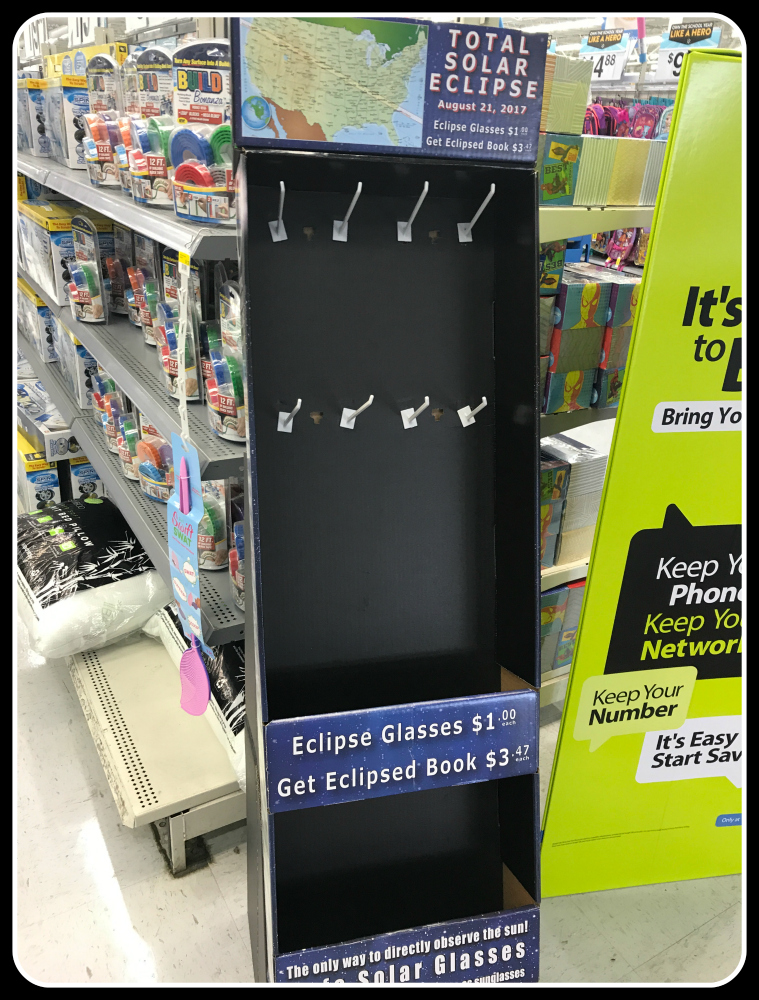Total Solar Eclipse: What Do I Need?
The Great American Solar Eclipse is less than two weeks away!
Monday, August 21st will be here soon. If you’re in the path of totality (as we explained in our last blog post) or near it, it’s time to start thinking about what you need for your best eclipse viewing experience.
 You probably already know you’re not supposed to look directly at the full or partially-eclipsed sun with the naked eye. So that you can watch the eclipse as it progresses, get eclipse-viewing glasses with NASA-recommended ISO 12312-2. Regular sunglasses are NOT safe for eclipse viewing. NASA has specific tips here to help you be safe while enjoying your eclipse viewing.
You probably already know you’re not supposed to look directly at the full or partially-eclipsed sun with the naked eye. So that you can watch the eclipse as it progresses, get eclipse-viewing glasses with NASA-recommended ISO 12312-2. Regular sunglasses are NOT safe for eclipse viewing. NASA has specific tips here to help you be safe while enjoying your eclipse viewing.
Of course, you might find some eclipse glasses that don’t seem to meet the ISO standard. The Washington Post, in this article, sums up the test to see if yours are okay: “When you look through them, you shouldn’t be able to see anything but the sun. Not the lights in your house, not the headlights on the street. Nothing but the sun.”
This same article goes on to list places carrying eclipse glasses. You can find them at retail stores such as Lowe’s, Walmart, Toys “R” Us, and Kroger, as well as convenience stores such as 7-Eleven, Circle K, Love’s Travel Stops, and Pilot/Flying J. A more comprehensive list is in the article. Some public libraries and other public organizations have free eclipse glasses, so it’s worth an internet search to see if any place near you is giving them away.
 We at 36U have found it’s too late to order online and receive delivery by the eclipse date, so your best bet now is to find a free source locally or go to a local store. We even found empty eclipse glasses displays locally. So you may have to go on a hunt (as we did) to find your glasses before the 21st!
We at 36U have found it’s too late to order online and receive delivery by the eclipse date, so your best bet now is to find a free source locally or go to a local store. We even found empty eclipse glasses displays locally. So you may have to go on a hunt (as we did) to find your glasses before the 21st!
We know a lot of you will want to try some photos of the eclipse on your phone. Here’s some advice from Mr. Eclipse on how to do that.
If you want to try an “old school” DIY viewing method, there’s always the pinhole viewer. National Geographic gives an easy version: “Make a simpler version of the solar eclipse viewer with two thin but stiff pieces of white cardboard. Punch a small, clean pinhole in one piece of cardboard and let the sunlight fall through that hole onto the second piece of cardboard, which serves as a screen, held below it. An inverted image of the sun is formed. To make the image larger, move the screen farther from the pinhole. To make the image brighter, move the screen closer to the pinhole. Do not make the pinhole wide or you will only have a shaft of sunlight rather than an image of the crescent sun. Remember, this instrument is used with your back to the sun. The sunlight passes over your shoulder, through the pinhole, and forms an image on the cardboard screen beneath it. Do not look through the pinhole at the sun.”
Finally, don’t forget plenty of water and sunscreen and whatever you need to entertain yourself during the two-and-a-half to around three hours that it will take for the eclipse to run its whole course from beginning to end.
Happy viewing!
 Total Solar Eclipse Part 1: Where Do I Go?
Total Solar Eclipse Part 1: Where Do I Go?
Total Solar Eclipse Part 2: What Do I Need?